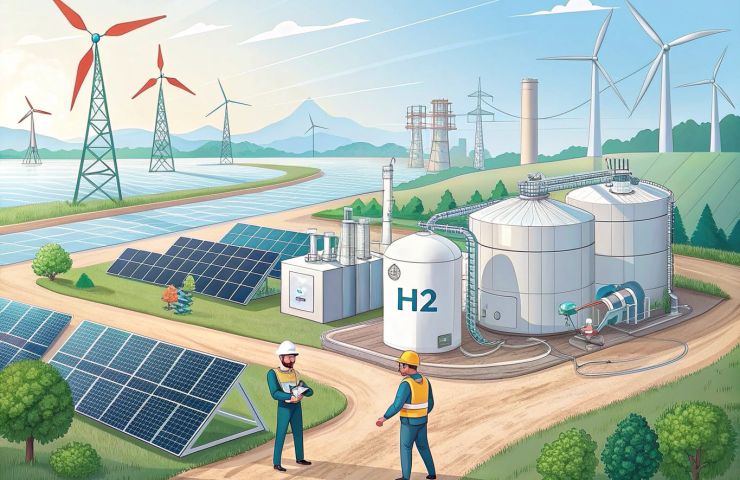
Hydrogen Production Gets Major Boost as Treasury Finalizes 45V Tax Credit Rules
July 11, 2025The U.S. hydrogen economy just hit a major milestone. On January 3, 2025, the U.S. Department of the Treasury finally rolled out its long-awaited rules for the Section 45V Clean Hydrogen Production Tax Credit. Fast forward just six months, and the U.S. House of Representatives passed an ambitious piece of legislation called the One Big Beautiful Bill Act on July 4. Together, these moves make one thing crystal clear—Washington is zeroing in on clean hydrogen as a big player in the future of sustainable energy. The goal? Get green hydrogen production moving, pull in investment, and take a serious bite out of industrial emissions.
Section 45V: A Game-Changer for Hydrogen Production
This tax credit, introduced under the Inflation Reduction Act (IRA) of 2022, offers a sliding scale of incentives—up to $3 per kilogram of clean hydrogen depending on how low their greenhouse gas emissions are. With the final rules now locked in, developers finally have the playbook they’ve been waiting on.
What makes this credit especially powerful is that it rewards cleaner tech. Think electrolysis powered by renewables—an absolutely essential part of producing truly green hydrogen. The new guidance lays out how producers should measure emissions and document their production, giving the industry the clarity it’s been pushing for.
“This unlocks long-awaited project financing,” said one seasoned renewables investor. “We’ve all been on pause—now things can really get moving.”
One Big Beautiful Bill: Big Changes, Mixed Feelings
Just when the momentum picked up for clean hydrogen, the One Big Beautiful Bill Act shook things up again. Passed on July 4, 2025, it didn’t just tweak renewable energy tax credits—it reshaped the whole landscape. The bill aims to streamline the system and cut down on long-term spending. In practice, though, that means some tax credits got trimmed or revamped, creating a bit of a rollercoaster for folks in the clean energy game.
On the plus side, the bill tries to speed things up—cutting red tape and giving projects a clearer, more scalable path forward. But the tradeoff is financial uncertainty for developers who now have to recalculate their plans. Some sectors, particularly non-hydrogen renewables, might feel the pinch. According to a June 2025 analysis by Holland & Knight, the changes could slow down investment in wind and solar while investors reassess the return on their money.
Why Now? Why Hydrogen?
There’s a clear reason why hydrogen is taking center stage. It’s one of the few clean fuels that can actually cut emissions in those heavy-duty sectors where electrification just doesn’t cut it. Hydrogen fuel—especially when produced cleanly—has huge potential in industrial decarbonization, sustainable aviation fuels (SAF), and freight transportation.
And here’s the bigger picture: it’s not just about carbon. It’s about global competition. While the U.S. picks up steam, countries across Europe and Asia are already off to the races, striking deals and building hydrogen export infrastructure. Green hydrogen is fast becoming a cornerstone of 21st-century economic strategy, and America clearly doesn’t want to get left in the dust.
What’s the Real-World Impact?
For hydrogen producers, this Treasury decision is the green light they needed. Now, projects can move forward with real clarity. For investors, it takes a lot of the guesswork—and risk—off the table. And for energy-heavy sectors like steel, chemicals, and aviation, access to low-carbon hydrogen might finally make industrial decarbonization financially viable.
That said, it’s not all smooth sailing. While hydrogen is getting a boost, other parts of the renewable energy mix might see fewer incentives. That could shift where the money’s going, pushing more capital toward hydrogen-centric strategies and away from solar or wind projects that once looked more profitable on paper.
What Comes Next: Building the Ecosystem
Tax credits are just one piece of the hydrogen puzzle. You still need buyers, pipelines, storage—plus, all of it has to line up with environmental justice and regional energy grid realities. The latest policy changes are a big push in the right direction, but it’ll take years before we see a true coast-to-coast hydrogen economy taking root.
Another piece to watch: stronger job creation. We’re talking about new factories, retrofitted ammonia plants, electrolysis units—all needing people to build and run them. It could create tens of thousands of jobs. But again, workforce training, permitting, and local planning could slow things down unless policymakers stay on top of it.
Bottom Line: The Race Is On
Here’s the takeaway: between the new 45V tax credit rules and sweeping changes from the One Big Beautiful Bill Act, America’s throwing its weight behind a lower-carbon future led by clean hydrogen. Sure, the road might wind a bit and there’s work left to do—but for the first time, producers and investors aren’t just talking about hydrogen. They’re building it.
2025 is shaping up to be a turning point—where the hydrogen industry shifts from cautious optimism to full-on action. The real question now is: can supply chains, infrastructure, and labor markets keep pace? We’ll have to wait and see, but one thing’s for sure—the foundation is finally in place, and the momentum is real.



 With over 15 years of reporting hydrogen news, we are your premier source for the latest updates and insights in hydrogen and renewable energy.
With over 15 years of reporting hydrogen news, we are your premier source for the latest updates and insights in hydrogen and renewable energy.
Thanks for this article. Complex topic, and I am trying to find out something simple – are the 45V credits are available for companies like Fuel Cell, Ballard, Bloom, and Plug. I am somewhat confused, even though I have read your and other articles. Can you clarify? Yes or No? Or, is it “maybe” depending on what DJT feels like on any given day?